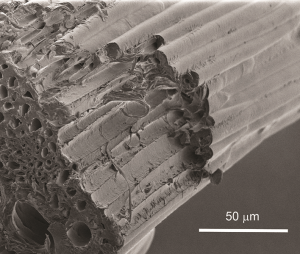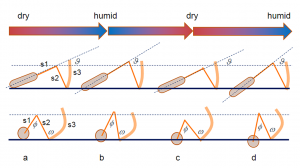Plants are able to thrive in varying climates owing to their ability to adapt. This has been made possible by incremental improvements in their energy‐conserving mechanisms, which tend to rely on gradients in temperature, light , pressure, and humidity.
Scientists from New York University Abu Dhabi provide a remarkable example of an evolutionary adaptation in the humble Stipa awn, which boasts a sophisticated system of dispersal and self‐burial of their seeds into the soil by utilizing fluctuations in aerial humidity, thus enhancing seed survival. The Stipa awn has a similar hygroactuation system as the flowering members of the Erodium genus, but with a few upgrades: kinks for effective positioning and hairs for aerial dispersal.

A typical S. epilosa awn has three mechanically coupled segments (proximal, middle, and distal) that have different morphologies and functionalities. The proximal segment provides the force required to thrust the diaspore into the soil, while the middle segment positions the diaspore at an angle that facilitates effective burrowing. In a dry state, the proximal and middle segments are twisted and stiff, providing mechanical support to the seed. In the presence of humidity, these segments untwist and expand, brought on by the swelling of the epidermis and external sclerenchyma cells, and the seed is thrusted into the soil. As the humidity decreases, the segments twist and shrink. This cycle repeats itself with changes in relative humidity, and each cycle results in deeper burial of the seed.
Furthermore, the barbs on the surface of the seed ensure unidirectional sliding. The distal segment is flexible and light, and thus assists in the aerial dispersal of the awn. In addition to maximizing resistance to air currents, the hairs are believed to also serve as surfaces for the collection of dew or rain that trigger the rotatory motion of the awn.

Such evolutionary adaptations that are based on responses to environmental stimuli are thought to be the core of the advancement of biomimetics. The authors hope that this mechanism demonstrated by the Stipa awn encourages the development of durable, artificial architecture that is independent of heat or light and powered solely by the daily variations in humidity to deliver small objects such as seeds, chemical reactants, and fertilizers using the same principle: a stiff segment that carries the cargo, another stiff segment that provides mechanical stability, and a third light segment that provides seamless aerial dispersion. Potential applications outside the general context of biomimetics also include power generators and smart textiles.

















